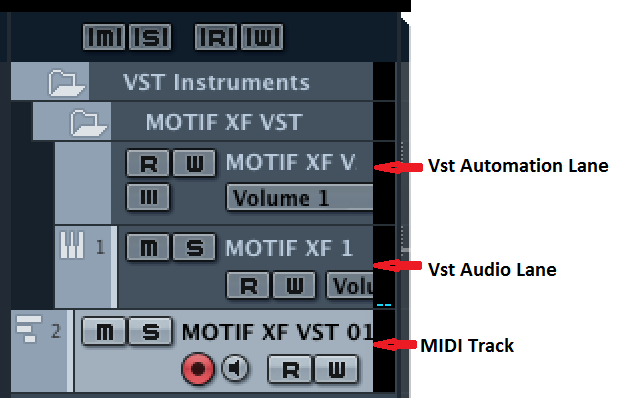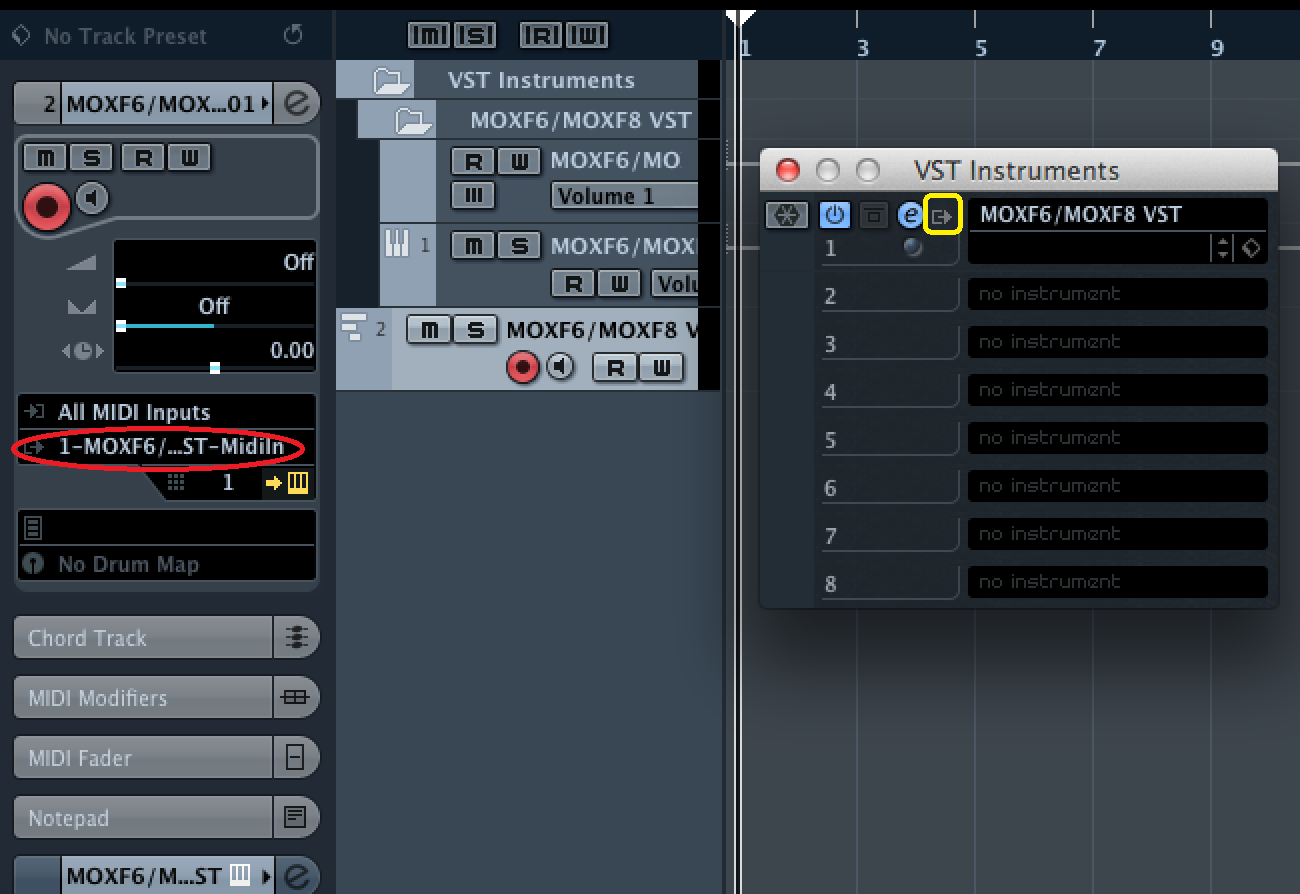I recorded a Cubase AI7 song - moxf midi tracks - added some audio of the keyboard (reverse wave stuff) and multiple vocal tracks.
Everything sounded good,,,until...
I was working with adding voices from Cubase VST presets and....
I must have messed something up because now I get a doubled and delayed midi playback.
So...how do I get back to the place where midi is playing normally while I monitor the audio tracks?
Thanks!
To understand this lets start by discussing how and why the doubling occurs. What is new and different in your setup is your audio interface happens to be also a synthesizer.
The MOXF, unlike your typical audio and MIDI interface, is capable of making sound! Let that sink in for a minute... Most garden variety Audio/MIDI interfaces do not make sound. The MOXF does not need a computer to be a sound device. It normally sends audio directly to its main left and right outputs. I'm not telling you anything you don't know, just making a point.
This connection between your MOXF and your speakers works even with the computer completely OFF. We will refer to this signal path as the "direct" audio path. Audio generated by the MOXF normally goes directly to the main OUTPUTS (simple enough).
Now the MOXF has a built-in audio (and MIDI) interface, which means it will deliver audio (and MIDI) to your computer DAW, which then also outputs audio to your speakers. The job of an audio interface is to be the routing center for sending audio into and getting audio back out of your computer. We will refer to this signal path as the "computer output"... The computer DAW outputs audio back to the MOXF which as audio interface then sends this signal on to your speakers. This second signal is slightly late (latency) because it has traveled back to the computer then is recorded/processed and then sent to the MOXF and its speaker outputs. It arrives precisely at the delay time shown by Cubase DEVICE SETUP > VST AUDIO SYSTEM ASIO Driver screen.
You have what are called DIRECT MONITOR options that you must learn to use so that you do not hear both the "direct" and "computer output" simultaneously.
Let's deal with MIDI first.
When you press a key on the MOXF, it normally sends this message to the MOXF tone generator which responds by generating audio that goes to the output. In a situation where you are recording to a DAW, you normally set what is called LOCAL CONTROL to OFF. This disconnects the MOXF keys and controllers from the MOXF tone engine, so that the messages travel OUT via USB-MIDI to the computer - where the active (selected) MIDI Track in Cubase "echoes" (also called "Thru) the signal to which ever MIDI device you target - be it back to the MOXF or to a VSTi or whatever you select. The MIDI Track also rechannelizes the data to one of 16 MIDI channels or if you set the CH = "Any" (the data will be routed bacl OUT on whatever channel it came IN on.
So to prevent doubling in your MIDI routing it is customary to set the LOCAL CONTROL = OFF in your MOXF.
Let's deal with AUDIO.
Again, when you press a key on the MOXF, it normally sends this message to the MOXF tone generator which responds by generating audio that goes to the main MOXF outputs. But it also is sending audio signal through the USB cable on to the computer which ultimately (also) outputs the audio to the audio interface (which as mentioned, happens to be the MOXF).
Very Important: AUDIO coming from the computer on its way to the MOXF's Main Output travels thrugh the DAW LEVEL control slider on the MOXF's front panel. If you do not have ths slider up you will not hear the audio coming from the computer.
The MOXF has several QUICK SETUPS designed to take care of the most commonly used configurations. It makes all of the critical settings for both MIDI and Audio routing - specifically avoiding situations where doubling occur. These settings are found on the lower left corner of the MOXF Editor VST and are also found on the UTILITY > [F5] USB I/O screen inside your MOXF.
If you are using the "4CH" (or dual Stereo) you will notice that by default the AD INPUT is assigned to USB 1/2 and the internal MOXF Parts are all routed to USB 3/4 (initially)... You will see these listed as:
AD IN & PART
PART
The USB 1/2 while it defaults to the AD INPUT can be used to output any of the MOXF internal PARTS when you want to isolate them for a separate Audio track. Each internal PART can be routed to USB 3/4 or to USB 1/2 as you require.
These DIRECT MONITORING options along with the LOCAL CONTROL settings are manipulated by the QUICK SETUP template you select, but you can (once you understand them) make these settings manually as you need.
We should mention quickly - that there are also Direct Monitoring options in Cubase (we'll get to those later).
Find the QUICK SETUP button on the front panel of the MOXF. Notice it is linked to the buttons just to the right of it by a series of dots. The buttons A, B, C, D, E and F are also numbered 1-6
Holding the [QUICK SETUP] + button [A/1] = DAW REC
Holding the [QUICK SETUP] + button [B/2] = ARP REC
Holding the [QUICK SETUP] + button [C/3] = ARP DIRECT
Holding the [QUICK SETUP] + button [D/4] = STAND ALONE
Holding the [QUICK SETUP] + button [E/5] = VST REC
Holding the [QUICK SETUP] + button [F/6] = VST PLAY
Each of these has a different purpose (as you can imagine). And each makes all the necessary settings for the MOXF for that purpose, even if you forget.
You would use DAW REC when recording the MOXF itself to Cubase.
You would use VST REC when recording a VSTi (on the computer).
You would use VST PLAY when playing back a VSTi from the computer.
Okay final item... audio options in the DAW
In Cubase when dealing with VST routing - you have a VST INSTRUMENT Folder with a SubFolder for each VST you elect to use. Each SubFolder will contain an AUTOMATION LANE and a virtual AUDIO LANE (where you can see the audio from the device registering)... This AUDIO LANE has a MUTE button which you can use when you'd rather listen to the "direct" signal.
Say you are overdubbing the MOXF to a MIDI Track. You want to hear what YOU are playing "direct" (zero latency)... in this case you would be using DAW REC (QUICK SETUP) and you would MUTE (m) the AUDIO LANE in the MOXF VST SubFolder. You would set the DAW LEVEL slider so you can hear the Metronome (click) from Cubase. The audio of what you are playing goes "direct" to the main outputs. You Mute the AUDIO LANE to prevent doubling.
When using the MOXF to control a computer-based VSTi, you want NOT to hear your MOXF... so the "VST REC" Quick Setup, has LOCAL CONTROL = OFF as one of its settings, and in this case you DO want to hear the AUDIO LANE of the VSTi SubFolder (so you would not Mute anything in Cubase). The Audio of the VSTi arrives at the MOXF's audio output through the DAW LEVEL slider.
Once you have recorded your VSTi use the QUICK SETUP template VST PLAY ([QUICK SETUP] + [6/F])
Hope that helps.
Okay final item... audio options in the DAW
In Cubase when dealing with VST routing - you have a VST INSTRUMENT Folder with a SubFolder for each VST you elect to use. Each SubFolder will contain an AUTOMATION LANE and a virtual AUDIO LANE (where you can see the audio from the device registering)... This AUDIO LANE has a MUTE button which you can use when you'd rather listen to the "direct" signal.
I'm not sure that I understand what you mean by "VST INSTRUMENT Folder" "sub folder" and "Audio Lane" - can you show me a screen shots?
BTW I found out the source of the doubling - I think....
Somehow my MOXF got disconnected from the inputs when I was adding editor VST preset voices to my user voices....
So there was no input device showing...and it seems that when that is the state of Cubase AI7 connected to MOXF - then there is doubling AND delay happening when the DAW slider is up.
When I reset the input drivers to MOXF - everything worked normally again.


So there was no input device showing...and it seems that when that is the state of Cubase AI7 connected to MOXF - then there is doubling AND delay happening when the DAW slider is up.
When the DAW slider is up you are returning audio to the MOXF (as audio interface) from the DAW _ this will always be true unless you prevent it otherwise... one method is to press the Mute button on the MOXF VST Audio Lane. This is the audio going through a meter just before it is routed OUT of the computer and arrives at the DAW LEVEL slider of your MOXF. If you have a direct path active for your audio (that is, from the MOXF itself to the MOXF audio outputs) it only follows that the direct signal will be heard. It is your responsibility to prevent other audio pathways such that only one is active at a time.
There are basically two types of signal that travel through the DAW LEVEL slider:
1) Audio from any audio track or device in the DAW, this includes the audio from any VSTi you are running, it includes the Metronome Click from Cubase
2) Audio that has been RETURNED from the MOXF in response to MIDI data from a Cubase Track routed to MOXF VST-MIDI IN. This audio returns through the VST AUDIO LANE in the MOXF VST SubFolder. It is a SubFolder to the main VST INSTRUMENT Folder. You only want to hear the MOXF returning through this audio lane when you are using VST Effect plug-ins to further process the MOXF or when you are mixing down. Otherwise you want to hear what you are playing "live" direct. You always want to hear yourself without latency. Remember the MOXF signal that travels through Cubase to arrive at the DAW LEVEL slider is always the "latent" signal.
Hope that clears it up.
Thanks for the screen shots and the explanation.
Yes - I am now clear!
jb
